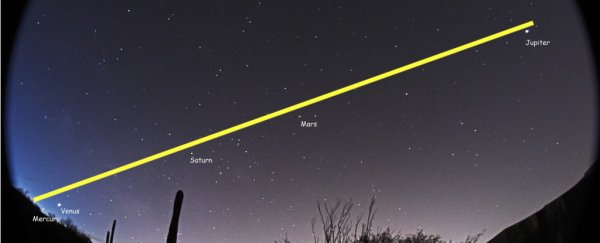Stargazers, get ready for an awesome natural phenomenon next month – five bright planets in our Solar System will align in the night sky, and will all be visible with the naked eye.
If you find a dark enough vantage point, you'll be able to check out Mercury, Venus, Mars, Jupiter, and Saturn tracing a glorious line away from the setting sun.
"The fainter planets that lie closer to the Sun, such as Mercury and Venus, will be difficult to see so it is best to wait until after sunset for the twilight to fully fade, but before the planets set," said Alan Duffy, an astronomer with Swinburne University of Technology in Australia.
"The planets stretch across the sky, anchored to the horizon following the setting Sun," he added.
"This is because the entire Solar System is flat like an old vinyl record with the planets moving along these grooves of the record. Looking out from the Earth we will see this as a straight line, known as the ecliptic plane, tracing across the sky."
Depending on where you are in the world, the best date and time to watch the skies will be different, but Duffy says that the challenge is to ensure that you don't end up missing Venus or Mercury as they move below the horizon.
"For Australia it's best to look west by 7pm towards the end of August," he said. "If you're in Europe or North America you need to wait later for the Sun to set around 9pm. Even then, the further you are from the equator the less time you'll have before the planets appear to vanish beneath the horizon."
So, in other words, it will be a quick dash between the time the Sun sets enough to see the planets, but before they get too low on the horizon. You can minimise any issues you might encounter though, by finding a flat plane and a dark unobstructed view.
"The best time to look is either side of the full Moon on 18 August as the light from the Moon washes out the fainter planets," Duffy says. "The most difficult planets to spot will be those fainter ones close to the horizon, so make sure to find somewhere dark with as clear a view as possible to the west where the Sun has set, meaning no low lying buildings or trees."
But seriously, you guys have got this! Getting out into darkness and nature have other benefits as well, so who's keen on a camping trip at the end of August? If you time it right, you might be able to see the tail end of the Perseids meteor shower, too.
"The event this year is your last chance to see all the visible planets together in the same night sky until 2018. It's a reminder of the size of the Solar System that these giant planets stretching over enormous distances appear to us no more than delicate lights strung across the sky," said Duffy.
Count us in.
Swinburne University of Technology is a sponsor of ScienceAlert. Check out their Open Day on July 31, and see Alan Duffy speak live about science in science fiction in a special free talk!
